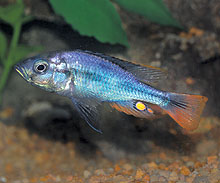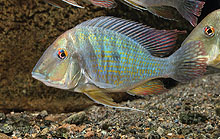WHAT'S NEW ACROSS THE WORLD
Select date in side bar to go to a What's New of previous issues
| What's New
©by Laif DeMason
Summer is fading away, bringing more temperate weather to most of the USA. And what a summer it was! Very hot in many parts of the country. So the welcomed cooler weather should encourage more people to move out of their indoor confines and frequent a local fish club, fish store, or regional fish show. Above all, hobbyists should follow their own individual interests and maybe not so much the popular opinions of the herd!
Here’s “what’s new” on the cichlid scene: |
Lake Tanganyika
Exports from around the lake and bred selections continue to be available to hobbyists. Shortages have appeared in small bred fish from the many popular Tropheus varieties. Wild adult Tropheus, however, are more than available from the new part-time importers that have taken up this endeavor.
| WHAT'S NEW: LAKE TANGANYIKA |

Recent imports from Tanzania contained Altolamprolotus compressiceps reportedly from Karema. This black type of A. compressiceps is not like most black varieties along the central Tanzanian coast which are generally grey-black, but rather it is coal black like some types from Zambia. Photo by A. Konings.
|

A large Cyprichromis offered as “pavo” is from the Kipili, Tanzania area. Males are somewhat bluish with a prominent yellow anal fin. The most interesting aspect of this fish is uncolored males and females seem to have wide vertical bars, and so do the fry.
|

Usually one of the last fish to be sold from any import shipment is Chalinochromis popelini. Recently this has not been the case with the few that arrived of late from Mkinga, Tanzania. The sudden demand made them a ‘sold out’ item quickly. Photo by A. Konings.
|

In several of the Cyprichromis sp. jumbo leptosoma locations, males have a yellow head. While capture, holding, and export shipping tend to promote loss of color in many wild cichlids, the color will more than come back given a good diet and secure surroundings once settled. Pictured here, an individual from Nkondwe Island, Tanzania.
|
Lake Malawi
Exclusive wild OB mbuna types are still very popular in Europe. Elsewhere hobbyists seem to prefer wild predator haplochromines. Of course, color is king and many other wild Malawi fish somehow fill this bill.

One of the many popular predator fish from Itungi, Tanzania, is Otopharnyx sp. ‘silver torpedo’, which usually arrives with no color. However, the males of these fish do develop coloration once settled in. Photo by A. Konings.
|

An absolutely new species collected in the Itungi area is perhaps a Tramitichromis species. This jumbo cichlid is a large blue-green fish that came in at about 6 inches. Since many were caught and it was unknown until now, likely this fish comes inshore seasonally. Hopefully we’ll see this fish again!
|

Another very rare cichlid that was imported in small numbers recently was Nyassachromis nigritaeniatus. Only a few males were offered so it is still very rare in the hobby. It is a colorful fish making it a good candidate for breeders. Photo by A. Konings.
|

A not often seen mbuna-type cichlid usually found over sandy areas is Gephyrochromis moorii. This fish was reportedly also from the Itungi, Tanzania area and sports a yellow throat area. Photo by A. Konings.
|
| WHAT'S NEW: VICTORIA & NEOTROPICS |

Luckily some professional cichlid breeders dig deep into their species reserve to vitalize a previously forgotten item. Pictured here is Yssichromis piceatus, a small torpedo-shaped fish which can occasionally be purchased. This cichlid has few demands for keeping it healthy in the aquarium.
|

Several species of wild Geophagus cichlids are regularly exported from Colombia. Pictured here a fish exported as Geophagus sp. ‘Caqueta’, likely from the G. surinamensis group. This species is not offered regularly, so interested parties should act now. Photo by O. Lucanus.
|
Select date in side bar to go a What's New of previous issues |









